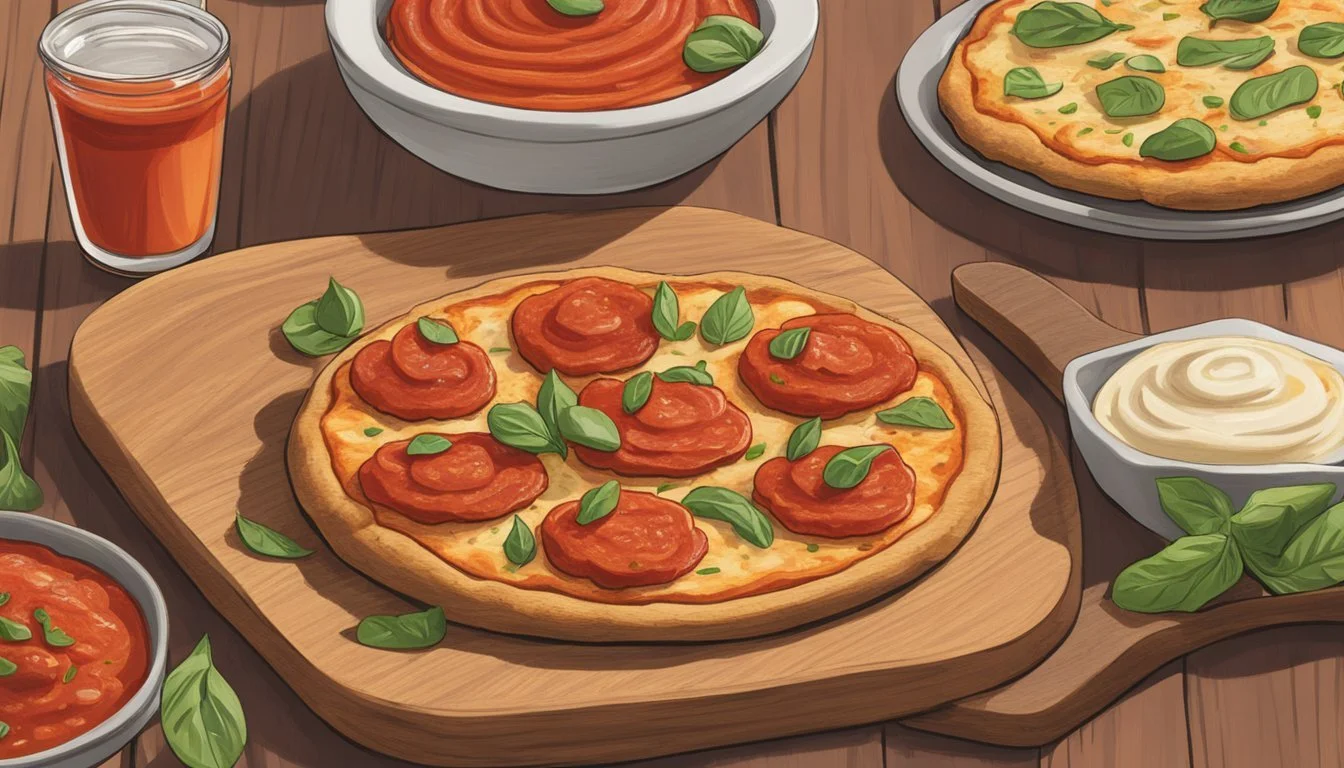How Long Do Gluten-Free Cauliflower Crust Pizza Bites Last?
Storage Tips and Shelf Life
When it comes to enjoying gluten-free cauliflower crust pizza bites, knowing their shelf life is crucial to maintaining taste and safety. These healthy snacks, popular for their grain-free and paleo-friendly appeal, have a limited window of freshness. Gluten-free cauliflower crust pizza bites can last up to 3-4 days in the refrigerator when stored properly in an airtight container.
For those who prefer to plan meals ahead, freezing is an excellent option. By storing the bites in a freezer-safe bag or container, they can be kept for up to two months. This method not only preserves their flavor but also ensures you always have a quick, nutritious snack on hand. Proper reheating techniques, such as using an oven or air fryer, can help retain their desired texture and taste.
Understanding the storage options and lifespan of these tasty bites encourages smarter meal planning and food safety. Whether refrigerated or frozen, gluten-free cauliflower crust pizza bites offer a convenient and healthy alternative for pizza lovers.
Understanding Cauliflower Pizza Bites
Cauliflower pizza bites are a popular gluten-free alternative to traditional pizza. These bites offer a nutritious and tasty option that caters to various dietary needs.
Cauliflower as a Healthy Base
Cauliflower serves as the essential base for these pizza bites. It's low in calories and high in fiber, making it an excellent substitute for flour. When cauliflower is riced and used in recipes, its mild flavor allows it to blend well with various seasonings and toppings.
To prepare cauliflower pizza bites, the cauliflower is typically riced and combined with ingredients like eggs, cheese, and spices. This mixture is then formed into small, bite-sized pieces and baked. The result is a tasty and healthier option compared to traditional pizza crusts.
Nutritional Benefits
Cauliflower pizza bites are packed with nutrients. They are a good source of vitamin C, aiding in immune function. Additionally, they contain fiber, which supports digestive health.
The bites also provide a decent amount of protein when ingredients like eggs and cheese are added. This makes them more filling and nutritionally balanced. Using cauliflower as a base reduces the carbohydrate content, making them suitable for those on low-carb diets.
Preparation Essentials
Creating gluten-free cauliflower crust pizza bites requires specific techniques and ingredients to achieve the ideal texture and flavor. This guide covers the crucial steps in making these pizza bites, from getting the perfect texture to choosing the right ingredients and baking them to perfection.
Creating the Perfect Texture
Start by making cauliflower rice using a food processor. The cauliflower should be riced to a fine, crumbly texture but not a paste. This helps to achieve and maintain the structural integrity when baking.
Next, the riced cauliflower should be cooked. Place it in a microwave-safe bowl and microwave for about 5 minutes, or until tender. Transfer the cooked cauliflower to a cheesecloth and squeeze out as much moisture as possible. Removing excess water is essential to prevent a soggy crust.
Mix the dry cauliflower with an egg and a blend of cheeses like mozzarella and parmesan to bind the ingredients efficiently. This will help the crust hold together and stay firm when baked.
Choosing the Right Ingredients
Selecting high-quality ingredients is vital. Fresh cauliflower is preferred, though pre-riced cauliflower can save time. Blending almond flour or coconut flour into the mixture can enhance texture and flavor.
Incorporate a mixture of cheeses for both taste and structure. Mozzarella provides elasticity, while parmesan adds depth of flavor. An egg acts as a binder, ensuring the ingredients form a cohesive mixture.
Spices such as Italian seasoning and red pepper flakes can elevate the taste of the crust. Use salt and pepper to enhance the flavors without overpowering them.
Molding and Baking
First, preheat the oven to 400°F and line a mini muffin tin or a baking sheet with parchment paper. This prevents sticking and ensures even baking.
Scoop the cauliflower mixture into the muffin tin, pressing it down to form small, bite-sized bases. Alternatively, shape the mixture into small rounds on the parchment-lined baking sheet.
Bake the formed bites for 20-25 minutes, or until they are golden brown and firm to the touch. This baking time ensures the cauliflower crust sets properly and achieves a crispy, enjoyable texture. Keep an eye on the bites to prevent overcooking.
Cooling the pizza bites slightly before serving allows them to firm up further, making them easier to handle and eat. Enjoy your gluten-free cauliflower crust pizza bites fresh for the best texture and taste.
Seasonings and Flavorings
Seasonings and flavorings play a significant role in enhancing the taste of gluten-free cauliflower crust pizza bites. The right combination of herbs and spices can turn a basic recipe into a culinary delight.
Herbs and Spices for the Pizza Bites
Italian seasoning usually forms the base for the seasoning mix. This blend often includes dried oregano, basil, and thyme. They provide a balanced and aromatic backdrop.
Adding garlic powder gives a robust and savory depth. Salt and black pepper enhance the overall taste by balancing flavors and giving a subtle kick. A pinch of red pepper flakes can introduce a little heat, perfect for those who enjoy a bit of spice.
In addition, sprinkling fresh basil after baking can add a fragrant and slightly sweet finish.
Customizing Your Flavor Profile
To create unique flavor profiles, you can experiment with various herbs and spices. For a Mediterranean twist, incorporate zataar or sumac.
For a more aromatic and earthy profile, consider adding rosemary or thyme. Smoked paprika can lend a smoky depth ideal for a BBQ-style bite.
Fresh herbs such as cilantro or parsley can be added as a garnish for freshness. You might also mix in some parmesan cheese with the spices for a cheesy depth.
By adjusting these seasonings, each batch of pizza bites can have a new and exciting flavor.
Pizza Toppings and Variations
When it comes to customizing gluten-free cauliflower crust pizza bites, the selection of toppings is crucial for both flavor and dietary preferences. Considering the wide array of available ingredients, it's possible to create nearly any flavor profile you desire.
Choosing Toppings for Your Diet
Selecting the right toppings often starts with dietary preferences and requirements. For those looking to keep it traditional, pepperoni and mozzarella cheese are classic choices. Low-carb and keto-friendly diets might favor high-fat toppings like parmesan cheese and olive oil.
Vegetarians can opt for a variety of vegetables such as peppers, mushrooms, spinach, and olives, pairing well with marinara sauce or pizza sauce. If you are focusing on protein, chicken and ham can be great additions. Think about using onion and tomatoes to add extra layers of flavor and nutrition.
Exploring Creative Combinations
For those eager to experiment, mixing and matching toppings can lead to delicious results. Chicken, onion, and spinach can combine for a hearty and nutritious option. Pepperoni with mozzarella cheese, parmesan, and a sprinkle of olives can create a rich and savory bite.
For a Mediterranean twist, try using feta cheese, spinach, black olives, and tomatoes. If you prefer a BBQ flair, consider topping with barbecue sauce, chicken, onion, and bell peppers. Parmesan cheese and fresh herbs like basil can accentuate the natural flavors of the cauliflower base.
Storage and Shelf Life
Proper storage can extend the shelf life of gluten-free cauliflower crust pizza bites, ensuring they remain fresh and safe to eat. Key considerations include refrigeration and freezing methods.
Refrigerating Pizza Bites
Store leftover pizza bites in an airtight container to maintain freshness. Refrigeration will keep them safe to eat for up to 3-4 days.
Excess moisture can make the crust soggy, so it’s best to place a paper towel inside the container to absorb any condensation.
Reheat refrigerated bites in an oven or toaster oven at 375°F for 5-7 minutes to enjoy crisp crusts similar to when they were freshly baked.
Freezing and Reheating
For longer storage, freeze pizza bites in a single layer on a baking sheet before transferring them to a freezer-safe bag or container. They can last up to 2 months in the freezer without losing quality.
When ready to eat, reheat frozen bites directly from the freezer. Use an oven preheated to 400°F, and bake for 10-12 minutes. This method keeps the crust crunchy and prevents excessive moisture buildup.
Label containers with the date to keep track of their freshness and ensure optimal storage practices.
Serving Recommendations
Gluten-free cauliflower crust pizza bites are versatile and perfect for various occasions, from casual snacks to elegant party appetizers. Effective presentation and thoughtful pairings enhance the experience.
Presentation and Pairings
For presentation, arrange the pizza bites neatly on a large platter. Adding fresh herbs like basil or parsley provides visual appeal.
Consider pairings to complement the flavors:
Dips: Serve with marinara sauce, pesto, or a creamy garlic dip.
Beverages: Offer sparkling water, light wines, or craft beers.
For a more sophisticated touch, pair with an arugula salad, lightly dressed with lemon vinaigrette, balancing the richness of the cheese and crust. This ensures an enjoyable experience for all.
Health Considerations
Cauliflower crust pizza bites align with various diets and are suitable for individuals avoiding common allergens. These considerations support a wide array of dietary needs ranging from keto to gluten-free diets.
Dietary Adaptations
Cauliflower crust pizza bites are a versatile option for multiple dietary plans. They are grain-free and naturally gluten-free, making them excellent for those with celiac disease or gluten sensitivity. The inclusion of cauliflower, often a staple in keto and low-carb diets, keeps carbohydrate content low while offering a nutritious alternative to traditional crusts.
For those on a paleo diet, using cauliflower crusts ensures compliance by avoiding processed grains and refined sugars. They can also be adapted for vegetarian and vegan diets by substituting dairy-based cheese with vegan cheese or nutritional yeast.
Allergen-Free Options
Cauliflower crust pizza bites can cater to numerous allergens. Using cauliflower bypasses common allergens such as wheat and other grains, supporting a grain-free lifestyle. By opting for vegan cheese or nutritional yeast, individuals avoid dairy, which is beneficial for those with lactose intolerance or dairy allergies.
Moreover, swapping out eggs with flaxseed or chia seed mixtures makes these bites suitable for those with egg allergies. Ensuring ingredient quality and avoiding cross-contamination in preparation processes can further enhance allergen safety.
These adaptations make cauliflower crust pizza bites a broadly accessible and healthy option for various dietary and allergen-sensitive needs.
Additional Cauliflower Creations
Beyond just pizza bites, cauliflower can be transformed into a variety of delicious and healthy dishes. This section explores a few more options for incorporating cauliflower into your meals.
Recipes Beyond the Pizza Bites
Cauliflower Fried Rice
Cauliflower fried rice offers a low-carb alternative to traditional fried rice. Simply pulse cauliflower florets in a food processor until they resemble rice. Sauté the cauliflower rice with vegetables like peas, carrots, and green onions. Season with soy sauce or tamari for a gluten-free option. Adding an egg for extra protein is also an option.
Cauliflower Pizza Muffins
These mini cauliflower pizza muffins are a fun twist on traditional cauliflower pizza crust. To make them, press the cauliflower mixture into muffin tins and bake until the edges are golden. Add your favorite pizza toppings, like marinara sauce, cheese, and pepperoni. Bake again until the cheese is melted and bubbly.
Paleo Cauliflower Pizza Bites
For a paleo-friendly snack, consider paleo cauliflower pizza bites. Made without dairy or grains, these bites use a blend of cauliflower, almond flour, and eggs as the base. Season with Italian herbs and bake until crispy. Serve with your favorite paleo-approved marinara sauce for dipping.










